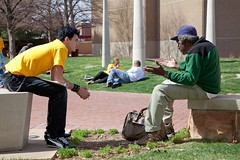Although homelessness is declining nationally, it is still increasing in many communities, including wealthy Santa Cruz, CA and Morristown, NJ. One reason the situation is improving in many communities is due to the Project Homeless Connect program, which Mayor Gavin Newsome created in San Francisco in 2004 and which now is providing needed services for people without homes in 220 communities and three countries. The federal government’s Interagency Council on Homelessness has declared Project Homeless Connect a national best practice model.
Project Homeless Connect holds large annual events at which homeless people can take advantage of numerous offered services, including dental care, eyeglasses, family support, food, HIV testing, housing, hygiene products, medical care, mental health services, substance abuse treatment, SSI benefits, legal advice, state identification cards, voice mail, employment counseling, job placement, wheelchair repair and veterinary services. Hundreds of individuals, corporations, nonprofits and government agencies provide these services.
Recently, more than 40 groups offered services at the fourth annual Project Homeless Connect event at the Santa Cruz Civic Auditorium. More than 700 people attended and took advantage of services including medical care, legal help, food and haircuts.
Kymberly Lacrosse, community organizer for United Way of Santa Cruz County, one of the organizers of the event, said:
It was a great turnout for clients. It was 700 people that didn’t get served yesterday or the day before. Even if it had only been 100, it’ would still be amazing.
According to a recent countywide survey, Santa Cruz County now has 3,536 homeless, up 41% from 2,265 in 2009. The City of Santa Cruz has 892 persons without habitation, or 31% of that total. Forty-four percent of the county’s homeless live on the street, 28% reside in cars or vans, 11% are in emergency shelters, 8% are in encampment areas, 7% are in emergency transitional housing and 2% sleep in abandoned buildings.
Thirty-eight percent of those experiencing homelessness for the first time had been homeless for a year or more. Thirty-one percent of survey respondents reported not receiving any government benefits. Twenty eight people spent one or more nights in jail or prison in the past year.
Three hundred and ninety-five of the county homeless were veterans, and 87% of those lived on the street. Five hundred and forty-four homeless people were in families. There were 128 unaccompanied children, and 97% of them were on the street.
Sixty-eight percent of survey respondents reported a disabling condition. Such conditions included mental illness (55%), substance abuse (26%), chronic physical illness (17%), physical disability (20%) and developmental disability (3%).Thirty-nine percent used emergency room services one to three times in the previous 12 months, and 21% did so four or times.
Affluent Morris County, NJ has seen homelessness rise by 13% over the past four years. Project Homeless Connect recently held an event in downtown Morristown where more than 200 people took advantage of services from haircuts to healthcare offered by 35 entities.
Why does such a rich area see homelessness increasing? Because modest gains in the economic recovery mean rents are rising high enough to disqualify people who depend on federal housing vouchers to subsidize their rents.
Lisa Falcone, director of Project HOMI (Homeless Outreach to People with Mental Illness) said:
When I started placing people in rooming houses five years ago, the rents per month for a room were about $200 less than they are now. Now you can rent a room for anywhere from $600 to $700 a month, and it’s hard to get a $500 room. The cost of utilities and overall living expenses has gone up, too. It’s difficult for people to make ends meet, and there’s a lack of jobs.
Some of the few affordable rental options are barely habitable. To make matters worse, the Congressional sequestration has reduced by 5% to 8% the number of HUD vouchers available in communities. Steve Berg, vice president of programs and policy for the National Alliance to End Homelessness, says:
At a time when there’s a lot of people in a lot of need, the program should be going up to meet the need, but instead, it’s going down.
The national alliance reports that sequestration puts at risk 125,000 individuals and families using vouchers nationwide, as well as another 100,000 in emergency shelters.
The 2013 Morris County Point in Time Count of the Homeless tallied 346 people, including 88 children, this past Jan. 30, an increase of 9% from 2011. Some estimate that the number of people who are homeless over the course of this year could be two to four times larger.
The Morris County Point in Time Count also revealed that 18% were unsheltered; 24 %were in their 40s; 31%had been homeless for more than a year; 60% were Caucasian and 60% suffered from a mental illness.
Project HOMI started the year with a caseload of 80 and is ending it with approximately 180, according to Falcone, whose mental health association also was involved with another 700 people.
Exacerbating the problem, Falcone said, is the reality that rooms with rents affordable enough to meet HUD voucher requirements are less likely to be in hub towns like Dover, Morristown or Parsippany, where there are services. Instead, they tend to be in outlying areas of the county, not close to public transportation, so these people can’t get to jobs or the treatments they need.
The recently updated Morris County Ten-Year Plan to End Homelessness calls for several measures, including the creation of a centralized homeless management information system as well as permanent housing solutions for specialized populations.








 Photography is a powerful tool for getting across the humanity behind the major issues of the day. Of course, at HUMAN
Photography is a powerful tool for getting across the humanity behind the major issues of the day. Of course, at HUMAN







